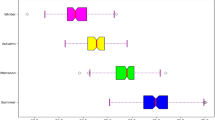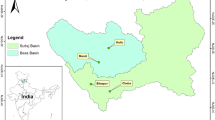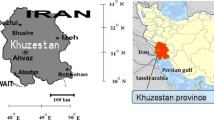Abstract
This study compares the daily potato crop evapotranspiration (ETC) estimated by artificial neural network (ANN), neural network–genetic algorithm (NNGA) and multivariate nonlinear regression (MNLR) methods. Using a 6-year (2000–2005) daily meteorological data recorded at Tabriz synoptic station and the Penman–Monteith FAO 56 standard approach (PMF-56), the daily ETC was determined during the growing season (April–September). Air temperature, wind speed at 2 m height, net solar radiation, air pressure, relative humidity and crop coefficient for every day of the growing season were selected as the input of ANN models. In this study, the genetic algorithm was applied for optimization of the parameters used in ANN approach. It was found that the optimization of the ANN parameters did not improve the performance of ANN method. The results indicated that MNLR, ANN and NNGA methods were able to predict potato ETC at desirable level of accuracy. However, the MNLR method with highest coefficient of determination (R 2 > 0.96, P value < 0.05) and minimum errors provided superior performance among the other methods.



Similar content being viewed by others
Abbreviations
- ETo :
-
Reference evapotranspiration
- ETC :
-
Crop evapotranspiration
- ANN:
-
Artificial neural network
- NNGA:
-
Neural network–genetic algorithm
- MNLR:
-
Multivariate nonlinear regression
References
Alizadeh A (2005) Principles of applied hydrology. Astan Ghods Razavi Press, Mashhad (in Persian)
Allen RG, Periera LS, Raes D, Smith M (1998) Crop evapotranspiration: guideline for computing crop water requirement. FAO Irrigation and Drainage Paper No. 56. Food and Agriculture Organization of the UN, Rome, p 301
Beale R, Jackson T (1991) Neural computing: an introduction. Adam Hilger, Techno House
Chauhan S, Shrivastava RK (2009) Performance evaluation of reference evapotranspiration estimation using climate based methods and artificial neural networks. Water Resour Manage 23(5):825–837
Curry B, Morgan P, Silver M (2002) Neural networks and non-linear statistical methods: an application to the modeling of price-quality relationships. Comput Oper Res 29:951–969
Dinpashoh Y (2006) Study of reference crop evapotranspiration in I.R. of Iran. Agric Water Manage 84:123–129
Gao R, Chaolunbagen C, Yu C, Zhu Z, Chai J (2006) Estimating reference crop evapotranspiration using artificial neural network based on random samples. Nongye Gongcheng Xuebao Trans Chin Soc Agric Engin 22:42–45
Goldberg DE (1989) Genetic algorithm in search, optimization and machine learning. Addison-Wesley, Reading
Hu YC (2009) Functional-link nets with genetic-algorithm-based learning for robust nonlinear interval regression analysis. Neurocomputing 79:1808–1816
Huo Z, Feng S, Kang S, Dai X (2012) Artificial neural network models for reference evapotranspiration in an arid area of northwest China. J Arid Environ 82:81–90
Jabloun M, Sahli A (2008) Evaluation of FAO-56 methodology for estimating reference evapotranspiration using limited climatic data: application to Tunisia. Agric Water Manag 95(6):707–715
Jensen, ME, Burman RD, Allen RG (1990) Evapotranspiration and irrigation water requirements. ASCE Manuals and Reports on Eng. Practice No. 70. American Society of Civil Engineers (ASCE), NY, USA
Kisi Ö (2006) Generalized regression neural networks for evapotranspiration modeling. Hydrolog Sci J 51:1092–1105
Kumar M, Raghuwanshi NS, Singh R, Wallender WW, Pruitt WO (2002) Forecasting evapotranspiration using artificial neural network. J Irrg Drain Eng 128:224–233
Kuo S-F, Chen F-W, Liao P-Y, Liu C-W (2011) A comparative study on the estimation of evapotranspiration using backpropagation neural network: Penman-Monteith method versus pan evaporation method. Paddy Water Environ 9(4):413–424
Landeras G, Ortiz-Barredo A, López JJ (2008) Comparison of artificial neural network models and empirical and semi-empirical equations for daily reference evapotranspiration estimation in the Basque Country (Northern Spain). Agric Water Manag 95:553–565
Lee TS, Najim MMM, Aminul MH (2004) Estimating evapotranspiration of irrigated rice at the West Coast of the Peninsular of Malaysia. J Appl Irrig Sci 39:103–117
Lopez-Urrea R, Martı′n de Santa Olalla F, Fabeiro C, Moratalla A (2006) Testing evapotranspiration equations using lysimeter observations in a semi-arid climate. Agric Water Manag 85:15–26
NeuroDimension, Inc (2005) Developers of NeuroSolutions v5.01: Neural Network Simulator. The World Wide Web address is www.nd.com, Gainesville, FL
Rahimi Khoob A (2008) Comparative study of Hargreaves’s and artificial neural network’s methodologies in estimating reference evapotranspiration in a semi-arid environment. Irrig Sci 26:253–259
Razi MA, Athappilly K (2005) A comparative predictive analysis of neural networks (NNs), nonlinear regression and classification and regression tree (CART) models. Exp Syst Appl 29:65–74
Sabziparvar AA, Mirmasoudi SH, Tabari H, Nazemosadat MJ, Maryanaji Z (2011) ENSO teleconnection impacts on reference evapotranspiration variability in some warm climates of Iran. Int J Climatol 31:1710–1723
Sabziparvar AA, Shetaee H (2007) Estimation of global solar radiation in arid and semi-arid climates of East and West Iran. Energy (Int J) 32:649–655
Sabziparvar AA, Tabari H (2010) Regional estimation of reference evapotranspiration in arid and semi-arid regions. J Irrig Drain Eng 136(10):724–731
Sabziparvar AA, Tabari H, Aeini A, Ghafouri M (2010) Evaluation of class A pan coefficient models for estimation of reference crop evapotranspiration in cold-semi arid and warm arid climates. Water Resour Manage 24(5):909–920
Sungwon K, Hung Soo K (2008) Neural networks and genetic algorithm approach for non-linear evaporation and evapotranspiration modeling. J Hydrol 351:299–317
Tabari H (2010) Evaluation of reference crop evapotranspiration equations in various climates. Water Resour Manage 24:2311–2337
Tabari H, Hosseinzadeh Talaee P, Abghari H (2012) Utility of coactive neuro-fuzzy inference system for pan evaporation modeling in comparison with multilayer perceptron. Meteor Atmos Phys 116:147–154
Tabari H, Hosseinzadeh Talaee P (2012) Multilayer perceptron for reference evapotranspiration estimation in a semiarid region. Neural Comput Appl. doi:10.1007/s00521-012-0904-7
Tabari H, Kisi O, Ezani A, Hosseinzadeh Talaee P (2012) SVM, ANFIS, regression and climate based models for reference evapotranspiration modeling using limited climatic data in a semi-arid highland environment. J Hydrol 444–445:78–89
Tabari H, Marofi S (2011) Changes of pan evaporation in the west of Iran. Water Resour Manage 25:97–111
Tabari H, Marofi S, Zare Abyaneh H, Sharifi MR (2010) Comparison of artificial neural network and combined models in estimating spatial distribution of snow depth and snow water equivalent in Samsami basin of Iran. Neural Comput Appl 19:625–635
Tabari H, Marofi S, Sabziparvar AA (2010) Estimation of daily pan evaporation using artificial neural network and multivariate non-linear regression. Irrig Sci 28:399–406
Tabari H, Martinez C, Ezani A, Hosseinzadeh Talaee P (2012) Applicability of support vector machines and adaptive neurofuzzy inference system for potato crop evapotranspiration forecasting. Irrig Sci. doi:10.1007/s00271-012-0332-6
Tabari H, Sabziparvar AA, Ahmadi M (2011) Comparison of artificial neural network and multivariate linear regression methods for estimation of daily soil temperature in an arid region. Meteor Atmos Phys 110:135–142
Trajkovic S, Todorovic B, Stankovic M (2003) Forecasting of reference evapotranspiration by artificial neural networks. J Irrig Drain Eng 129:454–457
Xu Peng JZ, Zhang SZ, Li RM (2006) Neural network model for reference crop evapotranspiration prediction based on weather forecast. Shuili Xuebao. J Hydraul Eng 37:376–379
Yang H, Griffiths PR, Tate JD (2003) Comparison of partial least squares regression and multi-layer neural networks for quantification of nonlinear systems and application to gas phase Fourier transform infrared spectra. Anal Chim Acta 489:125–136
Acknowledgments
The authors wish to thank the Islamic Republic of Iran Meteorological Office (IRIMO) for providing the requisite meteorological data. Special thanks are due to the different people who collected the weather data during 2000–2005 from Tabriz weather station.
Author information
Authors and Affiliations
Corresponding author
Rights and permissions
About this article
Cite this article
Aghajanloo, MB., Sabziparvar, AA. & Hosseinzadeh Talaee, P. Artificial neural network–genetic algorithm for estimation of crop evapotranspiration in a semi-arid region of Iran. Neural Comput & Applic 23, 1387–1393 (2013). https://doi.org/10.1007/s00521-012-1087-y
Received:
Accepted:
Published:
Issue Date:
DOI: https://doi.org/10.1007/s00521-012-1087-y




